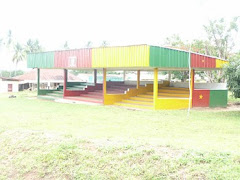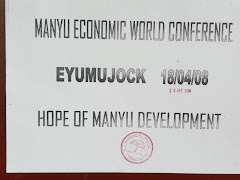Dear Conference Participants,
It gives me great pleasure to have been given this opportunity to address this historic gathering of the Sons and Daughters of Manyu, in my capacity as Patron to the Manyu Economic Development World Conference – MEDWC, which is taking place here in Eyumojock, Eyumojock Sub-division.
Two years since we successfully organised the Conference in Tinto, venue and focus have constitutionally shifted to Eyumojock today.
It gives me great pleasure to have been given this opportunity to address this historic gathering of the Sons and Daughters of Manyu, in my capacity as Patron to the Manyu Economic Development World Conference – MEDWC, which is taking place here in Eyumojock, Eyumojock Sub-division.
Two years since we successfully organised the Conference in Tinto, venue and focus have constitutionally shifted to Eyumojock today.
 H.E. Mengot Victor Arrey Nkongho (in blue suit)
H.E. Mengot Victor Arrey Nkongho (in blue suit)You will agree with me that MEDWC now provides us with an incontestable rallying ground for the architecture of a modern Manyu.
This has not been without great sacrifice from pioneers and the well known difficulties of birth which plagued the founding fathers through 1996 until 2003, when dynamic and foresighted patriots were voted in to lay the foundations of what has today become the single most credible unifying force for Economic Development of our division, Manyu.
Ladies and Gentlemen, the development of Eyumojock Sub-division which is the object of our presence here today has regrettably been long overdue, seeing the enormous natural, human and physical resources that nature has bequeathed the people of this Sub-division.
At the centre of this shortcoming is the deplorable state of road infrastructure which has emperiled Eyumojock’s geographic advantage as the gateway to the second largest economic block on the African continent.
Notwithstanding the staudy steadfastness and heroic resilience with which the Eyumojock people have borne these endless ordeals, I am pleased to inform you that the Government of the Republic of Cameroon has concluded the signature of financing packages for the construction of a first class transboundary highway from Ekok (Mfoum) to mile 42 (Number) in the Upper Banyang Sub-division.
Such coincidence of events, where efforts of my predecessors have culminated into irreversible successes during my own tenure of office as Patron of MEDWC, does not leave me indifferent. So I would like to use this august conference setting, to express my gratitude to His Excellency the Head of State, President Paul Biya, for this exceptional gesture of political goodwill towards the people of Manyu in General, to Eyumojock in particular and the whole nation at large, for enabling me, soon after my appointment into his government, to carry back to my division of origin, tidings of tangible economic accomplishments.
Fellow brothers and sisters, my heart throbs with hopefulness that after decades of oblivion, our division will once again emerge as the unavoidable triple-junction of national and international business and cultural transactions; a privileged role that she played in the days of our forbears because of her strategic geographic emplacement.
And now that we have come of age, let us emulate with fidelity, the solidarity and fraternity with which our parents conducted business in Manyu of S.A. George and Manyu of A.D. Mengot. We would not be doing these visionaries the justice they deserve if we, equipped as we are with great knowledge, in modern sciences and the arts, depart inadvertently into a Manyu of discord, antagonism and acrimony.
For my part, our vision of the new Manyu should be a modernised Division, where the development potentials of its four Sub-divisions are harnessed to their optimum by the complete disenclavement of Eyumojock, Akwaya, Upper Banyang and Mamfe Central; through viabilisation of its five-axis communication network i.e. Mamfe-Kumba-Buea; Mamfe-Fontem-Dschang; Mamfe-Ekok, Mamfe-Bamenda and Mamfe-Akwaya-Ogbudu.
It was the late President John Fritzgerald Kennedy of the United States of America who asserted that “it is from the construction of roads that America derived its wealth and greatness, not from the contrary.”
It was precisely because of this causal link that the disenclavement of the four Sub-divisions of Manyu remains a priority policy in MEDWC.
In April 2007, MAPADEF was successfully launched in Mamfe and we are confident to say that the creation of MAPADEF is a tangible manifestation of the vivacity and momentum with which MEDWC intends to accomplish its goals. Today Manyu has, if anything else, a pre-financial institution to its credit, which we hope to modulate into the proverbial backbone of economic development in Manyu.
Let me therefore use this august moment in calling on all our progressive forces – Businessmen, Entrepreneurs, Cooperatives and Investors to rally behind MEDWC, our MODUS VIVENDI and our paradigm for collective enterprise and development.
By so doing, we will be creating a vision of hope for economic emancipation of our people from poverty and hopelessness. Let us therefore grasp this golden opportunity afforded to us by MEDWC to make dividend by unlocking the colossal intellectual, cultural and physical resource potentials of our four Sub-divisions, which if unleashed would give significant moment to regional and international development and equilibrium.
Dear brothers and sisters, MEDWC is not and will never be a surrogate of political hegemony, nor will it be allowed to be transformed into a soap box for demagogy. It is, and will remain a forum for translating our patriotic agenda into fruitful economic achievement.
It is in this light that I would like to announce once more that MEDWC has not come empty handed to Eyumojock; MEDWC has come to immortalise its economic vision in Eyumojock with a giant oil palm plantation project, the economic impact of which cannot be overemphasised. President of MEDWC, Chief MBI ORUH Michael, will present this project to the Eyumojock community later on.
Around this vast oil palm estate project, we would like our brethren to intensify their agricultural activities – cocoa and coffee estates should be revived along with food crop cultivation. Do not forget that Eyumojock Sub-division alone in Manyu is endowed with rich volcanic soils such as we find elsewhere in the South West Province. Do take advantage of this endowment and make agriculture a profitable livelihood.
From my understanding of things, Manyu is a riverine Division and does benefit from an extraordinary bestowal of rivers, streams and brooks, which should become farms for pisciculture and semi-artisanal fishing. Ajah, Ndepajah and Monajah should be leaders in this trade.
We have come to awaken you to the several alternative livelihood possibilities that present themselves in Eyumojock. Transborder trade with our neighbours in Nigeria and the advent of TINAPA are opportunities that would make Dubai look a far fetched destination. Women and youths should be assisted to get a foothold in these opportunities, while the council needs to work out an action plan for boosting the tourism sector in the Sub-division.
As we leave Eyumojock at the end of is conference transactions, I wish all Manyu Sons and Daughters to beam their new focus on to Akwaya Sub-division for MEDWC 2010 and to come out with a befitting Economic Development Agenda, I dare say a martial plan for Akwaya’s total disenclavement and rehabilitation
Again I will like to thank you all for your patriotism and sacrifices for the course of economic development and peaceful co-existence. I promise on my part to uphold these ideals and employ all the means at our disposal to make our dreams come true.
I wish you all success during the conference deliberations and travelling mercies as you go back to your various destinations.































